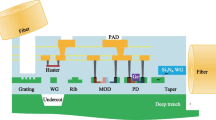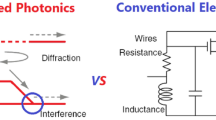Abstract
With the development of optical packet-switching (OPS) technologies, multi-fiber OPS networks will play an important role in the future data transmissions. In such networks, instead of constructing some extremely expensive node configurations with strictly non-blocking switching function, a more practical solution is multi-board switches that contain a number of small-sized switching boards. In this article, we have evaluated the performance of several different multi-board switches, based on the following two main objectives: (i) better understanding the effects of different connection schemes between switching boards and optical buffers and (ii) investigating possible schemes for achieving comparable performance to that of the ideal, strictly non-blocking switches. Extensive simulation results have shown that unlike circuit-switched net- works, multi-board OPS cannot easily perform comparably to the strictly non-blocking switch by having slightly more fibers per link. Also, such a problem can be tackled by several different approaches. The most efficient one is to equip the switch with more buffers rather than to increase the switching-board size or to enhance the buffer sharing between different switching boards.
Similar content being viewed by others
References
Ramaswami R., Sivarajan K.N.: Optical Networks: A Practical Perspective. Morgan Kaufmann Publishers (1998)
Ramaswami R. (2002) Optical fiber communication: from transmission to networking. IEEE Commun. Mag. 40(5): 138–147
Hunter D.K., Andonovic I. (2000) Approaches to optical Internet packet switching. IEEE Commun. Mag. 38(9): 116–122
Monacos S.P., Morookian J.M., Davis L., Bergman L., Forouhar S., Sauer J.R. (1996) All-optical WDM packet networks. IEEE/OSA J. Lightwave Technol. 14(6): 1356–1370
Chan V.W.S., Hall K.L., Modiano E., Rauschenbach K.A. (1998) Architecture and technologies for high-speed optical data networks. IEEE/OSA J. Lightwave Technol. 16(12): 2146–2168
Chlamtac I., et al. (1996) CORD: Contention resolution by delay lines. IEEE J. Select. Areas Commun. 14(5): 1014–1029
Hunter D.K., Chia M.C., Andonovic I. (1998) Buffering in optical packet switches. IEEE/OSA J. Lightwave Technol. 16(12): 2081–2094
Hunter D.K., Cornwell W.D., Gilfedder T.H., Franzen A., Andonovic I. (1998) SLOB: A switch with large optical buffers for packet switching. IEEE/OSA J. Lightwave Technol. 16(10): 1725–1736
Diao J., Chu P.L. (1999) Analysis of partially shared buffering for WDM optical packet switching. IEEE/OSA J. Lightwave Technol. 17(12): 2461–2469
Danielsen S.L., Hansen P.B., Stubkjaer K.E. (1998) Wavelength conversion in optical packet switching. IEEE/OSA J. Lightwave Technol. 16(9): 2095–2108
Ramamurthy B., Mukherjee B.3 (1998) Wavelength conversion in WDM networking. IEEE J. Select. Areas Commun. 16(7): 1061–107
Sudb A.S., Bjrnstad S. (2003) Scalable optical switch structure based on tunable wavelength converters and arrayed waveguide grating routers. OSA J. Optical Network 2(9): 340–349
Ciaramella E., Contestabile G., Curti F., D’Ottavi A. (2000) Fast tunable wavelength conversion for all-optical packet switching. IEEE Photonics Technol. Letts. 12(10): 1361–1363
Qin X., Yang Y. (2002) Nonblocking WDM switching networks with full and limited wavelength conversion. IEEE Trans. Commun. 50(12): 2032–2041
El-Bawab T.S., Shin J. (2002) Optical packet switching core networks: Between vision and reality. IEEE Commun. Mag. 40(9): 60–65
Yao S., Mukherjee B., Yoo S.J.B., Dixit S. (2003) A unified study of contention-resolution schemes in optical packet-switched networks. IEEE/OSA J. Lightwave Technol. 21(3): 672–683
Marsan M.A., Fumagalli A., Leonardi E., Neri F., Poggiolini P. (1998) Daisy: A scalable all-optical packet network with multifiber ring topology. Comput. Networks ISDN Syst. 30(11): 1065–1082
Li L., Somani A.K. (2000) A new analytical model for multifiber WDM networks. IEEE J. Select. Areas Commun. 18(10): 2138–2145
Gipser T., Jager H.A., Rapp L. (1998) Broadcasting, scalability, and reconfigurability aspects in an all-optical network architecture. Fiber Integrat. Optics 17(1): 21–40
Leung Y., Xiao G., Hung K. (2002) Design of node configuration for all-optical multi-fiber networks. IEEE Trans. Commun. 50(1): 135–145
Harai H., Wada N., Kubota F., Chujo W. (2002) Contention resolution using multi-stage fiber delay line buffer in a photonic packet switch. Proc. of IEEE ICC ’02 (New York, NY, USA) 5: 2843–2847
Jiang S., Hu G., Liew S.Y., Chao H.J. (2005) Scheduling algorithm for shared fiber-delay-line optical packet switches-part II: the three-stage clos-network case. IEEE/OSA J. Lightwave Technol. 23(4): 1601–1609
Li Y., Xiao G., Ghafouri-Shiraz H. (2004) On the benefits of multifiber optical packet switch. Microwave Optical Technol Letts 43(5): 376–378
Luo Y., Ansari N. (2003) Performance evaluation of survivable multifiber WDM networks. Proc. IEEE Globecom ’03 (San Francisco, CA, USA) 5, 2524–2528
Cao X., Anand V., Xiong Y., Qiao C. (2003) Performance evaluation of wavelength band switching in multi-fiber all-optical networks. Proc. IEEE INFOCOM ’03 (San Francisco, CA, USA) 3, 2251–2261
Nagatsu N., Watanabe A., Okamoto S., Sato K. Performance and node architecture of WDM multiple fiber ring networks. Proc. IEEE ICC’ 98 (Atlanta, GA, USA) 931–936 (1998)
Author information
Authors and Affiliations
Corresponding author
Rights and permissions
About this article
Cite this article
Li, Y., Xiao, G. & Ghafouri-Shiraz, H. On the performance of different node configurations in multi-fiber optical packet-switched networks. Photon Netw Commun 14, 11–22 (2007). https://doi.org/10.1007/s11107-006-0039-9
Received:
Accepted:
Published:
Issue Date:
DOI: https://doi.org/10.1007/s11107-006-0039-9




